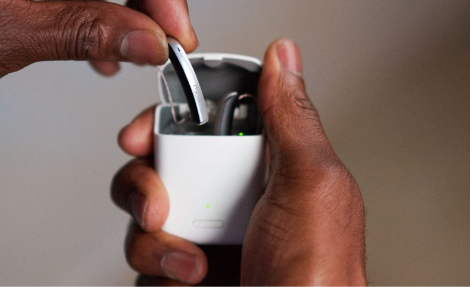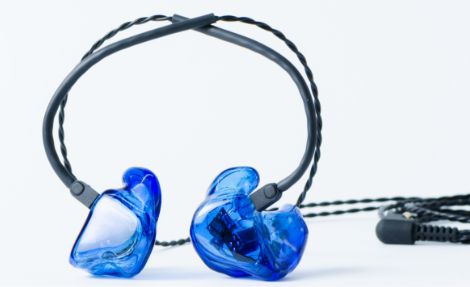Hearing Products
If a hearing aid or device is necessary for your hearing journey, our experts will guide you to the best solution. We offer the latest hearing technology and products that address a wide variety of hearing loss concerns, helping you reconnect to the world around you.
Hearing Technology
Modern Solutions For All Types of Hearing Loss
Thanks to advances in technology, hearing products are designed to be more compatible with our lives than ever before. In addition to hearing aids, there are a number of products that make living and communicating with hearing loss easier to manage, so you never miss a beat.
Hearing aids come in a wide variety of styles and offer a number of features at varying price points. The device you choose ultimately comes down to your hearing loss, lifestyle and budget. Our hearing aid styles guide can help you find the best match for your unique hearing needs.
More on Hearing Aid StylesThere are many Hearing Aid Compatible (HAC) cell phone accessories that can enhance the experience of your hearing aids. These are products that work with the settings on your hearing aids that allow for features like Bluetooth connectivity, hands-free calling and more. Many cell phones can be used with hearing aid telecoils. Hearing aid accessories that provide a hands-free option may also be helpful.
More on Cell Phone Accessories for Hearing Aids
Hearing Product Guide
Curious About Hearing Technology, but Not Sure Where to Start?
With so many styles and options, it can be difficult to know which products will suit your needs. Our Consumer Guide to Hearing Aids provides an in-depth breakdown of the different types of hearing devices, as well as the technology available for all types of hearing loss.
Hearing Aid Manufacturers
Hearing Products Created by the Best in the Industry
Park Place Hearing Center has been helping people in Marin and Sonoma counties live better lives through better hearing for over 30 years. Trust our hearing care professionals to provide you with an individualized recommendation for the hearing aid technology that best meets your needs. Because we represent many manufacturers, you benefit from a wide selection of the latest technology.
.
Oticon Hearing Aids & Accessories
Oticon wearable hearing technology is improving lives every day. Revolutionary hearing aids offer superior technology no matter your level of hearing loss. People with mild to profound hearing loss experience life-changing hearing experiences with Oticon.
View All ProductsPhonak Hearing Aids & Accessories
Phonak innovates with industry-leading hearing technology. Their expertise in creating hearing solutions for every level of hearing loss benefits anyone who needs assistance in hearing better. Hear naturally and understand speech brilliantly with hearing aids from Phonak.
View All ProductsReSound Hearing Aids & Accessories
The ReSound ecosystem of hearing products offers a solution to meet your hearing needs. Premium hearing aids deliver clear and distortion-free sound, so you hear effortlessly and clearly. Adapt to different hearing environments with a hearing experience as individual as your fingerprint.
View All ProductsSignia Hearing Aids & Accessories
Signia hearing aids create simply brilliant hearing experiences. Experience ground-breaking technology that allows for complete customization to deliver sound as you want to hear it. Signia helps you hear your best to live your life to the fullest.
View All ProductsStarkey Hearing Aids & Accessories
Starkey delivers the best hearing experience possible with their award-winning hearing aid technology. Innovative hearing solutions help you connect to better hearing experiences effortlessly. Enjoy conversations again with hearing aids from Starkey.
View All ProductsHearing Protection
Make Protection a Priority
Protecting your ears from noise damage is essential to healthy hearing. We carry a wide variety of options equipped with the latest features and customizations, so you can find the best fit for your lifestyle.
Noise damage is one of the leading causes of hearing loss, which is why hearing protection is essential for healthy hearing. While over-the-counter earplugs offer some protection, custom earmolds and earplugs are the most effective and comfortable options.
More on Custom Earmolds And EarplugsHearing protection is especially important for musicians, but so is being able to clearly hear the music being played. Luckily, there are earplugs and monitors specifically designed to allow musicians to listen for the correct notes, pitches and keys.
More on Earplugs And Monitors For MusiciansProtect your hearing in the field with ESP that allows you to still enjoy the sounds of nature. Hunt or shoot confident that background noise is suppressed along with sounds over 90 db. Custom-fit, in-the-ear hearing protection fits comfortably and amplifies the sounds you want to hear while suppressing damaging decibels.
More on Electronic Shooters ProtectionThe hearing care professionals at Park Place Hearing Center are experts in fitting custom hearing protection. Custom earmolds and earplugs block sound better than off-the-shelf solutions and are more comfortable to wear for hours on end. Whether you are exposed to noise at work or at play, let Park Place Hearing Center fit you with custom hearing protection.
More on Hearing Protection
Assistive Listening Technology
Additional Tools to Support Clear Communication
You don’t have to rely on hearing aids alone; assistive listening technology and compatible devices can help bring more clarity to conversations and are another great way to foster healthy communication and connections.






